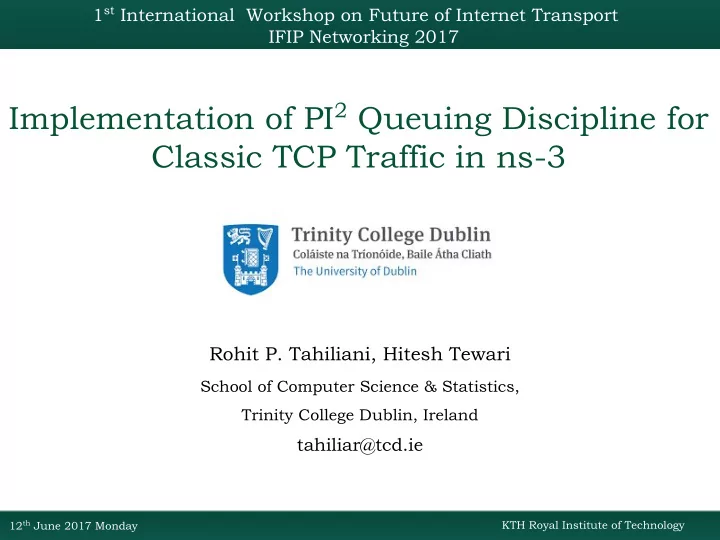

1 st International Workshop on Future of Internet Transport IFIP Networking 2017 Implementation of PI 2 Queuing Discipline for Classic TCP Traffic in ns-3 Rohit P. Tahiliani, Hitesh Tewari School of Computer Science & Statistics, Trinity College Dublin, Ireland tahiliar@tcd.ie 12 th June 2017 Monday KTH Royal Institute of Technology
Outline of the presentation ● Introduction: Bufferbloat , PIE, PI 2 ● Motivation ● Contributions ● Implementation details ● Model evaluation ● Functional verification ● Conclusions & Future Work ● Relation to the Future of Internet Transport ● Acknowledgements 12 th June 2017 Monday KTH Royal Institute of Technology
Introduction: Bufferbloat ● Inexpensive memory. ● Side effect : Bloated buffers at routers! ● Bufferbloat : large queueing delays ● Potential solution : deploy AQM algorithms to control queue delay Popular AQM algorithms: ● RED / Adaptive RED [S. Floyd, V. Jacobson, … ] ● CoDel / Fair Queue CoDel [K. Nichols, V. Jacobson, … ] ● PIE [R. Pan, P. Natarajan, … ] 1 12 th June 2017 Monday KTH Royal Institute of Technology
Introduction: PI 2 ● PI 2 - Extends PIE to support Classic & Scalable Congestion Control. Three major components of PI 2 : ● Random dropping - based on drop probability. PI 2 applies the squared drop probability. ● Drop probability calculation - happens at a regular interval. ● Average departure rate estimation - only when there is sufficient amount of data. 2 12 th June 2017 Monday KTH Royal Institute of Technology
Motivation ● Latency of 300ms appears to be “slow” [1] ● Bufferbloat makes the situation worse. Why implement PI 2 in ns-3: ● No support of PI 2 in network simulators. ● Adds value to the ongoing research work to solve Bufferbloat. ● ns-3: several new features compared to other simulators. [1] Grigorik, I. (2013). High Performance Browser Networking: What every web developer should know about networking and web performance. "O'Reilly Media, Inc.". 3 12 th June 2017 Monday KTH Royal Institute of Technology
Contributions Developed a new model for PI 2 in ns-3. ● ● Preliminary verification by writing test cases in ns-3. ● Evaluation by comparing results obtained from ns-3 PIE model and ns-3 PI 2 model. ns-3 PI 2 model is currently under review and can be accessed here [1]. ● Limitations: Currently, this ns-3 PI 2 model supports only Classic Traffic. ● [1] https://codereview.appspot.com/314290043/ 4 12 th June 2017 Monday KTH Royal Institute of Technology
Implementation details Source location: src/traffic-control/model/pi-square-queue{.h, .cc} Fig. 1: Class diagram for PI 2 model in ns-3. 5 12 th June 2017 Monday KTH Royal Institute of Technology
Implementation details Fig. 2: Interaction between the core methods of PI 2 6 12 th June 2017 Monday KTH Royal Institute of Technology
Model Evaluation ● A test suite for evaluating the working of PI 2 algorithm. - verifies the attribute settings of PI 2 parameters. - basic enqueue / dequeue of packets. ● Compare PI 2 in ns-3 with PIE in ns-3 under same scenarios. ● Performance metrics under observation: - Queue delay. - Throughput. 7 12 th June 2017 Monday KTH Royal Institute of Technology
Functional verification Four simulation scenarios: 1. Light TCP traffic 2. Heavy TCP traffic 3. Mix TCP and UDP traffic 4. CDF of Queuing Delay Table 1: Simulation Setup 8 12 th June 2017 Monday KTH Royal Institute of Technology
Functional verification: Light TCP traffic Fig. 3: Queue Delay with Light TCP traffic. 9 12 th June 2017 Monday KTH Royal Institute of Technology
Functional verification: Light TCP traffic Fig. 4: Link Throughput with Light TCP traffic. 10 12 th June 2017 Monday KTH Royal Institute of Technology
Functional verification: Heavy TCP traffic Fig. 5 : Queue Delay with Heavy TCP traffic. 11 12 th June 2017 Monday KTH Royal Institute of Technology
Functional verification: Heavy TCP traffic Fig. 6: Link Throughput with Heavy TCP traffic. 12 12 th June 2017 Monday KTH Royal Institute of Technology
Functional verification: Mix TCP and UDP traffic Fig. 7: Queue Delay with mix TCP and UDP traffic. 13 12 th June 2017 Monday KTH Royal Institute of Technology
Functional verification: Mix TCP and UDP traffic Fig. 8: Link Throughput with mix TCP and UDP traffic. 14 12 th June 2017 Monday KTH Royal Institute of Technology
Functional verification: CDF of Queue Delay 20 TCP flows and target delay = 5ms 20 TCP flows and target delay = 20ms Fig. 9: CDF of Queuing Delay with 20 TCP flows. 15 12 th June 2017 Monday KTH Royal Institute of Technology
Functional verification: CDF of Queue Delay 5 TCP + 2 UDP with target delay=5ms 5 TCP + 2 UDP with target delay=20ms Fig. 10: CDF of Queuing Delay with 5 TCP and 2 UDP flows. 16 12 th June 2017 Monday KTH Royal Institute of Technology
Conclusions & Future Work ● A ns-3 model for PI 2 has been implemented and evaluated. ● Results obtained are compared to those of ns-3 PIE model. Next Tasks: ● Extend PI 2 to work with Explicit Congestion Notification (ECN). ● Merge it into the main line of ns-3. ● Extend PI 2 in ns-3 for Scalable Congestion Control such as DCTCP. ● Compare PI 2 in ns-3 with PI 2 implementation in Linux. 17 12 th June 2017 Monday KTH Royal Institute of Technology
Relation to the Future of Internet Transport This work is inline with the ongoing research in the area of: ● DualQ Coupled AQM for Low Latency, Low Loss Scalable throughput. ● TCP Prague. 18 12 th June 2017 Monday KTH Royal Institute of Technology
Acknowledgements ● To all the reviewers, for the highly effective reviews! ● Prof. Stein Gjessing for shepherding our paper. ● Workshop organizers for providing this opportunity. ● Trinity College Dublin, Ireland for providing financial assistance. 19 12 th June 2017 Monday KTH Royal Institute of Technology
Thank you.
Recommend
More recommend